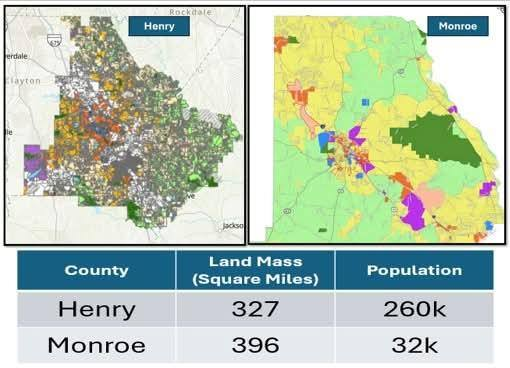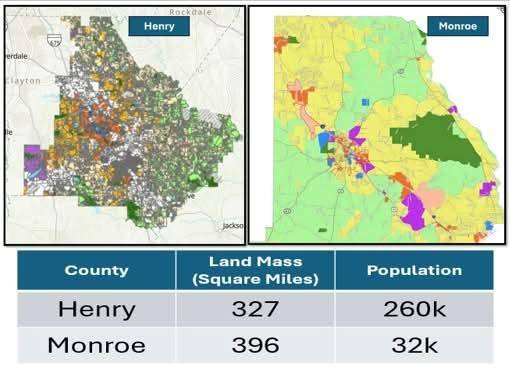By Mark d’Agostino
This is a multi-part article that will examine the history and current state of both Henry and Monroe Counties, and will focus on their growth, history, and trajectory. It will examine the mechanisms that drive and guide growth and will attempt to expose how these mechanisms will affect the future of Monroe County.
In order to do that, one must first gain a baseline of where these counties are and how they got there.
This installment will focus on Henry County.
Editor’s Note: Mark d’Agostino ran for BOC in Monroe County District 4 Commissioner in the
recent special election. During the campaign, numerous people told him, “don’t let
Monroe become Henry County”, he claims. He decided to investigate how HC became
what it is today and what role the P&Z processes played in that evolution.
Henry County Today, by its Citizens in Their Own Words:
“I moved from Henry a few months ago and still own a business there and I will say for sure the issue with HC is roads and traffic congestion. In my honest opinion, the main thing that could have avoided the mess they are facing is they should have had roads correct before they allowed the additional warehouses, homes and apartments to be built.”
“We left Henry County and moved to Monroe in early 1999. Back then Kellytown was the same as Culloden (near a state hwy but not near the interstate). When it became the place unrecognizable as it is now, is shortly after county water was piped to Kellytown. The reason it went to crap was Kellytown now had the infrastructure to support massive industry and commercial businesses.”
“HCO had zero forward thought for anything. And the DOT is 10 years behind still.”
“The traffic, the overcrowding, the crime, the higher property taxes, the roads 15 years behind in updating for traffic patterns, the immense amount of truck traffic, the entire stretch of i-75 that runs through hc, the lack of anywhere decent to eat besides tired chain restaurants, the school systems downturn, the overbuilding of mass housing instead of single family homes, squeezing in subdivisions with 200 houses that are zero lot line in every crevice they can find, highways that don’t have enough lanes for the amount of traffic that travels through, The list goes on.”
What’s the “Official” perspective?
Per the HC website, one is led to believe that HC has, “A high quality of life, low cost of living, easy access to downtown Atlanta, historical and cultural amenities, outdoor and recreational opportunities and highly-ranked educational institutions, Henry will prove to be the right move.”
Per the HC Comprehensive Plan 2045, The County has undergone remarkable changes. The county has been growing at a pace that outstrips its neighbors; development is happening in all corners, particularly new residential growth; and its warehousing and distribution centers are busier than ever.
So…what is the real state of HC? Let’s start at the beginning:
Early settlers found Henry County a virgin wilderness, having just been ceded from the Creek Nation. Prior to 1821, the Creeks, a few trappers and traders were the only residents of this area. The Creek Indians left their mark through place names, a few small Indian Mounds scattered around the county and through the arrowheads and broken pottery which can be found throughout Henry County. Even in the latter part of the 20th century, HC was largely agrarian, with produce and animal farms in much of the county.
A landmark event in HC was the building of the Atlanta Motor Speedway in 1960. The Speedway has had a checkered financial history and today is used as a multi-purpose venue, including fairs, shows and camping events. Nevertheless, the Speedway did draw attention and tourism to the county.
Henry County has faced increasing traffic congestion, particularly along Interstate 75 in McDonough. In 2024, this stretch was ranked as the 12th-worst freight bottleneck in the United States, an improvement from its 13th position in 2023. Similarly, the I-75 at I-675 junction in Stockbridge was ranked 92nd in 2024, down from 57th in 2023. Despite these improvements, average speeds have declined, indicating ongoing traffic challenges.
On the education front, Henry County has 15 Failing Schools, representing 38 percent of the overall.
Henry County has experienced significant population growth. Between 2010 and 2022, the population increased from 203,922 to 254,613, a growth of approximately 24.8%. This surge has led to increased population density and heightened demand for housing, infrastructure, and services.
Is HC really the mess people say it is?
In a recent town hall meeting, one participant voiced,
“The whole county is a joke. Why keep building? Make Henry county beautiful by destroying the farms and trees to make
it a concrete jungle??”
Another participant voiced this perspective:
“They screwed us on the Future Land Use Map, October 30, 2023…what they passed allowing all of this out of control and unplanned growth was never ever in the “Draft shown to the public and voted down on October 17, 2023.”
The rapid growth of a county like Henry has led to various challenges, especially if infrastructure development does not keep pace with population increases.

While the Monroe County Future Use Map shows a plan for the community, the Henry County Map shows a patchwork of spot zoning changes.
Will the same be the future for Monroe?
Here are some reasons why residents might be leaving and what could have gone wrong:
1. Inadequate Infrastructure: As population increased, essential infrastructure such as roads, public transportation, schools, and healthcare facilities have become overwhelmed, resulting in congestion, longer commute times, and reduced quality of life.
2. Housing Shortages: Rapid growth led to a housing boom, of varying densities and costs. Despite supply increases, ownership costs have followed national increase trends.
3. Public Services Strain: Essential services like law enforcement, fire departments, and waste management struggle to keep up with the growing population, leading to decreased safety and community satisfaction.
4. Leadership and Governance: If local leaders fail to anticipate and manage growth effectively, it can result in a perception of mismanagement. Residents may lose faith in their local government’s ability to address their needs. Leadership’s failure to develop in accordance with the Future Use and Comprehensive Plan is seen as a key contributing factor.
5. Quality of Life Concerns: Rapid growth can lead to a deterioration of community cohesion, increased crime rates, and a general decline in the quality of life. If residents feel that their community is no longer safe or enjoyable, they may decide to relocate.
6. Planning and Zoning Issues: From the Henry County 2045 Comprehensive Plan: “An analysis of major developments in the past five years revealed that about 20% of developments approved significantly deviated from the future land use map. Some were complete departures, but more commonly there were changes that typically resulted in higher than envisioned densities and the relaxing of mixed use standards. Not only has this caused issues in planning accurately for services and infrastructure, it has also bred an environment of distrust and sense of futility in the planning process. Many stakeholders have noted “why even do a plan if we won’t follow it?”
Addressing these issues requires a comprehensive approach, including strategic planning, community engagement, and investment in infrastructure and services.
It may be helpful for community leaders to conduct assessments and gather feedback from residents to identify specific concerns and work collaboratively towards solutions.
The next installment will look into how these critical planning and zoning processes work, follow an actual example, and report on what Henry County is doing to combat the rising issues of crime, overcrowding, traffic and failing schools.







